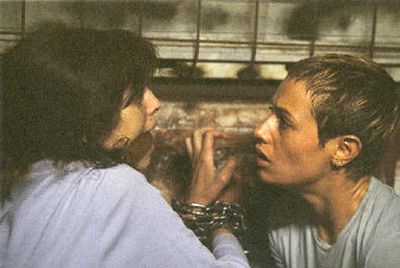Magic power of blood

Yeeeouch!
I reached into a drawer where I thought I’d dumped my reading glasses and instead encountered the business edge of a hunting knife. There’s a reason you should store knives in sheaths.
Anyway, you know that feeling when the blade cuts deep? It doesn’t hurt so much – yet – but it goes straight to your subconscious with all sorts of disturbing intimations of mortality.
Then, the blood. It poured out – so fast, like salad dressing spotting everything, turning sticky quickly.
So bright, too; is anything in nature that bright? The color is somehow coded to beam laserlike into your sluggish consciousness with messages of danger. Nobody ignores blood.
Yet the blood was at least familiar. I’d just seen gallons of it in the new French film “High Tension,” surely one of the most blood-soaked films of recent release.
And it’s just the start: The upcoming summer at the theaters appears to be an especially bloody one.
Not only is “High Tension” splattering plasma everywhere, but next Friday, George Romero, who made a fortune and a reputation off arterial spray, is bringing out “Land of the Dead” – supposedly the pièce de résistance in the zombie oeuvre, which he invented and perfected.
Then there’s something called “Undead,” a 2003 deal obviously hauled into the marketplace to take advantage of zombie mania; it opens July 1.
And on July 22, gore trifecta is completed with “The Devil’s Rejects,” which isn’t about zombies but good old-fashioned trailer park trash with guns and knives, killin’ folks left and right. It’s directed by old-style rocker Rob Zombie (no, he actually isn’t a zombie, though he was the lead singer of White Zombie).
Some of these may be good; I have high hopes for Romero, who is a talented outlaw and whose 1978 “Dawn of the Dead” is some kind of great American movie (I’m not sure what kind).
What they are selling, however, is something unique and specific. It’s not horror. There are other horror movies, and the tendency in horror movies of late has been to show less rather than more.
It’s not fear they’re selling, either, though all the films will surely provide a startle or two. Still less is it the sophisticated state known as dread, which is as much intellectual as anything and beyond the reach of most splatter flicks.
No, it’s the same start I got when the hand came out of the drawer and scarlet rivulets began snaking down my wrist and I thought one word: death!
That’s what blood does – it announces the presence of death. Death is there, palpably, breathing down our necks, and you better pay attention or it’ll grab you.
The movies have always understood the magic power of blood, and they play with it in a variety of ways.
For a while it was vivid in its absence. It was a great taboo and could be represented only symbolically; baby boomers remember the little smudge of chocolate syrup in a jillion B-movies of the ‘40s and ‘50s that announced the presence of a mortal wound. It was absurd but it was a convention and, like most conventions, transcended logic.
So when the hero’s best pal had that telltale trickle of dark moisture and lay back in the hero’s arms and remembered Mary Sue or The Coach or Grandpa Jones, we all knew the trickle stood for something more grotesque.
Blood, its own self – raw, red, wet and demanding that attention be paid – entered the mainstream from the bottom.
The films of a fellow called Herschell Gordon Lewis in the mid-‘60s (after his pioneering work in the nudist-camp genre, with “Daughter of the Sun”) were made for a few bucks in the Florida swamps, amateurishly acted on plots that could have been diagrammed on the back of a cigarette pack. And they were selling only one product, which was red, liquefied and all over the joint.
The first, in ‘63, was called “Blood Feast.” It showed you stuff you’d never seen before, unless you’d hit the beach at Iwo Jima or Normandy. The follow-ups were “Scum of the Earth,” “Two Thousand Maniacs!” and on and on.
The empire of the middle struck back with the more respectable Hammer films, horrors from England that were much more refined, but still showed extraordinary visions of the body violated in full “Hammer Color”! The films had a patina of classicism – they were variations on Frankenstein and Dracula tales – but the news was in the splatters.
Blood had gone fully mainstream by 1967, when Warren Beatty’s Clyde Barrow shot a banker through the back window of his ‘32 Ford and we saw the face shattered into a bloody mess from the bullet.
Two years later, it was here to stay, when Sam Peckinpah’s “The Wild Bunch” fetishized entry and exit wounds in slo-mo so that each bullet’s passage through the body was choreographed to the blossoming of a multi-petaled flower of gore.
It was a great movie, but for two solid years, every single movie had bloody deaths by gunshot in slo-mo. That’s the way it works.
Now, it comes and goes. It came again in the early ‘80s, on the strength of the slasher films – the first “Halloween” represents the high end, the last on the low end – which again shocked us until we grew bored; then they went away.
Until now. They’re back.
Don’t go in the water: It’s bloody.